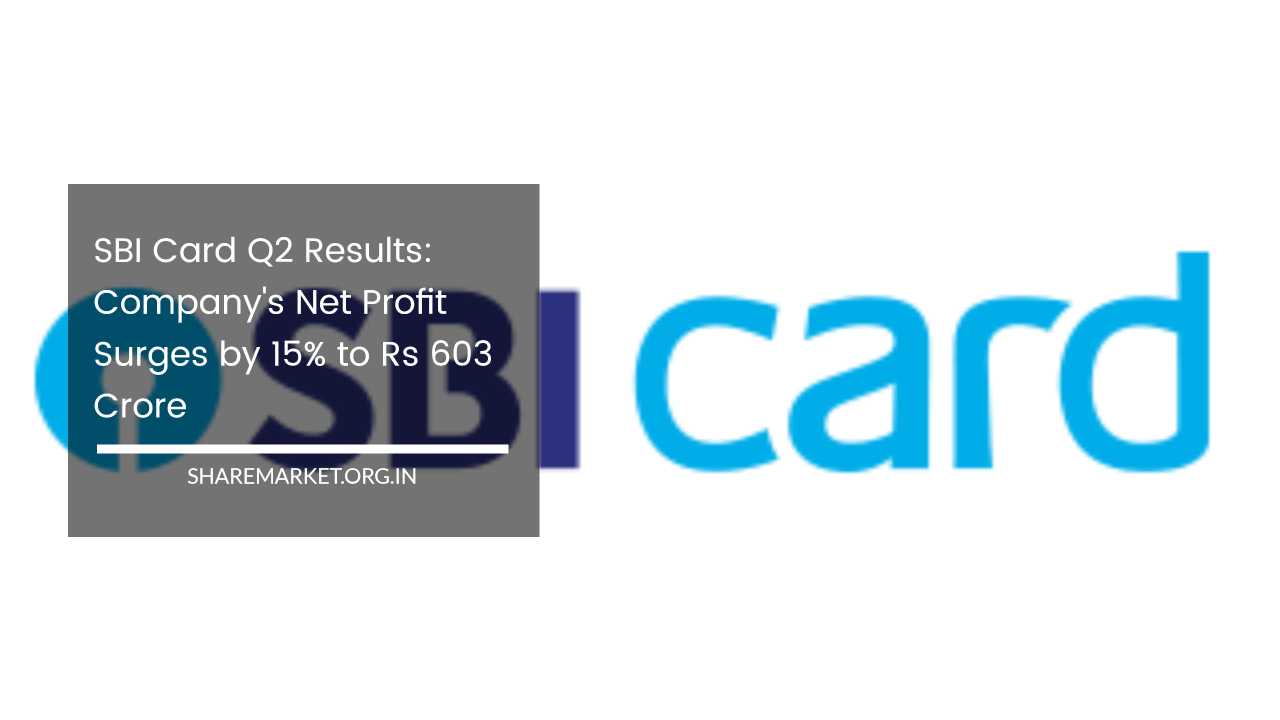SBI Card Q2 Results: Company’s Net Profit Surges by 15% to Rs 603 Crore

SBI Card Q2 Results
SBI Card Q2 2023 Financial Results Analysis: Net Profit Surges Amidst Challenges
SBI Cards and Payments Services Limited, commonly known as SBI Card, recently released its financial results for the second quarter of 2023.
The figures reveal a dynamic performance, marked by a 15% increase in net profit. This growth is notable, especially considering the challenging economic landscape.
In this analysis, we delve deeper into the key aspects of SBI Card’s Q2 results, shedding light on factors that contributed to this impressive performance, as well as areas that warrant closer attention.
1. Net Profit and Income Growth
The standout highlight of SBI Card’s Q2 results is the remarkable 15% increase in net profit, which surged to Rs 603 crore.
This performance is indicative of the company’s ability to navigate the complex financial landscape effectively. A substantial part of this success can be attributed to an increase in income during the same period.
SBI Card’s regulatory filing reveals that in the corresponding period in the previous year, the company’s net profit was Rs 526 crore.
This suggests a substantial upswing in the company’s financial performance, showcasing a growth trajectory that is indeed commendable.
In addition to the surge in net profit, the total income of the company also witnessed robust growth, increasing by 22% to reach Rs 4,221 crore during the quarter.
This double-digit growth in total income is an indication of the company’s effective strategies in income generation.
2. Interest Income and Other Sources
Diving deeper into the financial components, we find that the second quarter of the financial year 2023-24 saw a significant increase in SBI Card’s interest income.
This income source witnessed a remarkable growth of 28%, reaching Rs 1,902 crore. The surge in interest income is a reflection of the company’s prudent lending practices and effective management of interest-earning assets.
Moreover, income from other sources also increased by 21% to Rs 2,186 crore during the same quarter. This diverse income stream includes fees, commissions, and other non-interest-based revenue sources.
The impressive growth in this category highlights SBI Card’s ability to leverage multiple income streams, which is crucial for maintaining financial stability and growth in a dynamic economic environment.
3. Asset Quality and Non-Performing Assets (NPAs)
While SBI Card’s income and profit numbers present a positive picture, there were some concerns related to the company’s asset quality. During this period, the company’s asset quality exhibited a slight deterioration.
The gross non-performing assets (NPAs) increased to 2.43% of gross advances, up from 2.14% in the same quarter of the previous year.
This increase in NPAs could be attributed to various economic factors, including the ongoing pandemic and the associated economic challenges.
Nonetheless, it’s worth noting that SBI Card’s asset quality remains relatively healthy when compared to industry standards.
The increase in NPAs, while concerning, is not at alarming levels. However, it does underscore the importance of vigilant risk management and credit assessment practices.
Specifically, the company’s net NPA, often referred to as bad loans, increased by 0.89% in the quarter of September 2023.
This is a moderate increase from the 0.78% observed during the same period in the previous year. Managing and addressing these bad loans will be a critical aspect of SBI Card’s ongoing financial strategy.
4. Capital Adequacy and Net Worth
One of the cornerstones of a financial institution’s stability is its capital adequacy. SBI Card reported that its capital adequacy ratio was 23.3% at the end of the second quarter, a figure comparable to that of the September 2022 quarter.
A stable capital adequacy ratio is essential for weathering economic uncertainties and ensuring the ability to meet financial obligations, including regulatory requirements.
The company’s capital adequacy indicates that it has the necessary financial cushion to absorb unexpected losses and maintain business operations.
This is a positive sign for investors and stakeholders, as it demonstrates a commitment to financial prudence and regulatory compliance.
As of September 30, 2023, the net worth of SBI Card stood at Rs 11,130 crore, showing an increase from the figure of Rs 9,902 crore as of March 31, 2023.
This growth in net worth underscores the company’s positive financial trajectory and its ability to generate shareholder value.
5. Economic and Competitive Landscape
SBI Card’s Q2 results are set against the backdrop of a challenging economic landscape, marked by economic uncertainties, shifts in consumer behavior, and regulatory changes.
These factors can have a substantial impact on the financial performance of credit card companies like SBI Card.
One notable factor is the ongoing economic impact of the COVID-19 pandemic. The pandemic has had far-reaching effects on the economy, affecting consumer spending patterns, employment, and financial stability.
In such a scenario, SBI Card’s ability to not only maintain but increase its net profit is a testament to its adaptability and resilience.
Additionally, the credit card industry is highly competitive, with multiple players vying for market share. Innovation and differentiation in products and services are crucial for attracting and retaining customers.
SBI Card’s ability to stand out and grow its market share in this competitive landscape is an impressive feat.
6. Future Outlook and Strategies
SBI Card’s Q2 results provide insight into the company’s financial health and performance. While the company has shown remarkable growth in net profit and income, there are challenges in the form of deteriorating asset quality and increasing NPAs.
Moving forward, it will be essential for SBI Card to address these concerns effectively.
Maintaining a robust risk management framework and credit assessment practices will be critical to managing and reducing NPAs. Additionally, the company may need to explore strategies for enhancing asset quality and reducing credit risk.
SBI Card’s ability to generate diverse income sources is a strength that can be leveraged for continued growth. The company should continue to explore opportunities to diversify its income streams and expand its product offerings.
In an ever-evolving financial landscape, staying ahead of the curve in terms of technology and digital innovation is vital. Consumers increasingly demand convenient and secure digital banking and payment solutions. Adapting to these changing preferences will be pivotal in sustaining and expanding market share.
Final Remarks
SBI Card’s Q2 2023 financial results showcase a commendable growth in net profit and total income. The company’s ability to navigate challenges in the economic and competitive landscape is a testament to its adaptability and resilience. However, concerns related to asset quality and NPAs warrant attention and proactive measures.
Sustaining and building upon this growth will require a balanced approach that combines risk management, innovation, and diversification of income streams.
The stability in capital adequacy and growth in net worth are positive signs that position SBI Card well for the future.
As the financial landscape continues to evolve, SBI Card’s ability to adapt and address the changing needs of consumers will be pivotal in its ongoing success.
With the right strategies and a proactive approach to risk management, the company is poised to maintain its positive trajectory and continue to be a significant player in the credit card industry.

















